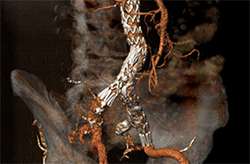Abdominal aorta screening: Stopping the stomach's timebomb

Many people carry a ticking time bomb inside themselves. Their abdominal aorta is dangerously dilated and may tear any time. This is an acute life-threatening condition. New screening allows doctors to detect and avert the danger.
With increasing life expectancy, the number of people who develop problems with their aorta (main artery) is also increasing. Doctors call the most common and dangerous complication an abdominal aortic aneurysm. The main blood vessel in the abdomen expands so much that it threatens to burst. If it does, a great deal of blood floods into the abdomen within seconds, and the person often dies before they can be hospitalized.
"Thus far, aneurysms have usually been discovered by accident, since they hardly cause any symptoms at first," says Professor Dr. Friedhelm Beyersdorf, Medical Director of the Department of Cardiovascular Surgery of the University Heart Center Freiburg - Bad Krozingen. That could now change.
A wire mesh, which doctors push over the inguinal vein to the correct place on the artery, can prevent a life-threatening tear of the aorta.
A 10-minute ultrasound scan can save lives
Since the start of 2018, German health insurance funds have been paying for check-ups for men over 65 years old, as four to eight percent of men at this age have a dangerous vascular dilation. During the examination, the doctor measures the diameter of the abdominal aorta using an ultrasound device. If it is less than 2.5 centimeters, the finding is normal. If the aorta is more than three centimeters wide, the patient must be checked ultrasonically every six months. From five centimeters, doctors consider it an aneurysm requiring treatment. Any doctor can conduct the ultrasound screening.
Those affected almost never have symptoms - until it's almost too late
Mostly, those affected have no symptoms. "That's why it's so important for all men to be screened," says Professor Beyersdorf. Only shortly before the aorta is about to rupture do they perceive pain, usually in the back. Then an immediate operation is necessary.
Four out of five patients can receive minimally invasive care
At the Department of Cardiovascular Surgery of the University Heart Center Freiburg - Bad Krozingen, around 400 patients are treated for a dangerous aortic tear each year. "The abdominal aorta can be treated with open surgery or minimally invasively. The type of surgery chosen always depends on the patient and his illness," says Professor Beyersdorf.
In the minimally invasive procedure a wire mesh, called a stent graft, is moved under X-ray control over the inguinal veins to the place where the bulge is, and then expanded. This is called an endovascular procedure. Around 80 percent of all patients with an aortic aneurysm undergo minimally invasive treatment at the University Heart Center. In acute and particularly complex cases open surgery is performed.
After the operation comes aftercare: The aorta passport helps
"We are firmly convinced that aftercare is just as important as preoperative preparation and treatment," says Professor Beyersdorf. Therefore, all patients treated for aortic aneurysm at the University Heart Center are also examined regularly in the aortic outpatient clinic.
The patient's "aorta passport" includes information about their condition, the procedures that have taken place, a sketch of their main artery, the date of their next check-up, and the most important contacts in the University Heart Center. This ensures that the time bomb in their stomach does not threaten to tick again unnoticed.
Back